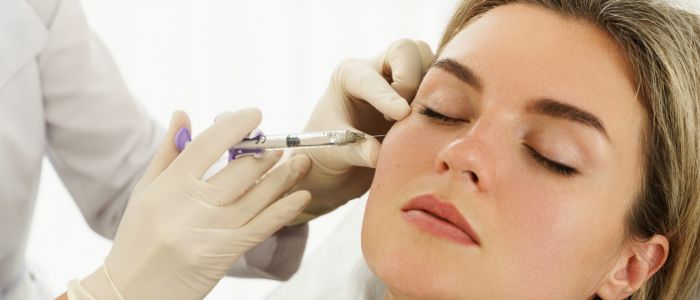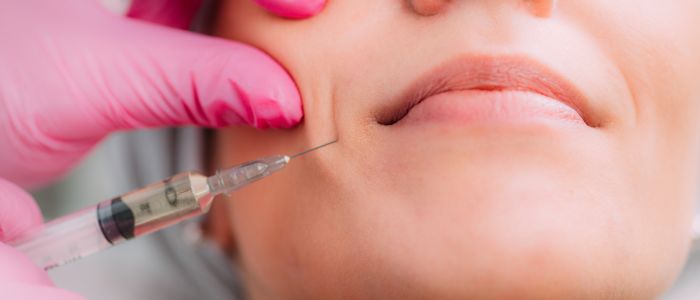
Table of Contents
- The Truth about Dermal Filler Complications (And How to Stay Safe)
- Overview of Dermal Fillers and Potential Complications
- Immediate Complications of Dermal Fillers
- Delayed Complications of Dermal Fillers
- Minimising the Risks: What We Do
- What You Can Do: Pre and Post-Treatment Care
- Managing Complications
- FAQs about Complications of Fillers
- Further Reading about Dermal Fillers at Cheshire Cosmetic Surgery
The Truth about Dermal Filler Complications (And How to Stay Safe)
Dermal fillers have become increasingly popular in recent years as a minimally invasive way to rejuvenate the face and address signs of ageing. While generally safe and effective, like any medical procedure, there are potential complications associated with dermal fillers.
Consultant Plastic Surgeon Anca Breahna always prioritises patient safety and strives to provide you with the best possible outcomes. In this blog, Anca aims to provide you with detailed information about the potential complications of dermal fillers and how you can work together to avoid and manage them.
Overview of Dermal Fillers and Potential Complications
Dermal fillers are gel-like substances injected beneath the skin to add volume, smooth wrinkles, and enhance facial contours. They primarily consist of hyaluronic acid, a naturally occurring substance in the body that provides hydration and plumpness to the skin.
While generally safe, potential complications can occur, ranging from mild and temporary to more serious. These can be broadly categorised as:
Immediate Complications of Dermal Fillers
While most patients experience minimal discomfort after dermal filler injections, it’s important to be aware of potential immediate complications. These typically occur within the first 24-48 hours after the procedure.
- Pain, Swelling, and Bruising: It’s completely normal to experience some degree of pain, swelling, and bruising at the injection sites. This is a natural response to the needle punctures and the filler being introduced into the skin. The extent of these effects varies depending on individual sensitivity, the type of filler used, and the treatment area. We use fine needles and can apply topical anaesthetic to minimise discomfort during the procedure. Applying ice packs to the treated areas after the injections can further help reduce swelling and bruising.
- Redness and Itching: You may notice some redness and mild itching around the injection sites. This is usually a temporary reaction to the injections and typically subsides within a day or two. Over-the-counter antihistamines or hydrocortisone cream can provide relief if needed. However, if you experience intense itching, a rash, or other signs of an allergic reaction, contact us immediately.
- Infection: While rare, infection is a potential risk with any injection procedure. We maintain strict sterile techniques throughout the process to minimise this risk. This includes using sterile needles, preparing the injection site with antiseptic solution, and wearing gloves during the procedure. It’s important to follow our post-treatment care instructions carefully, such as avoiding touching the treated areas to prevent introducing bacteria.
- Allergic Reactions: Allergic reactions to dermal fillers are uncommon, especially with hyaluronic acid-based fillers, as hyaluronic acid is a naturally occurring substance in the body. However, if you have a history of allergies to any injectable products or the ingredients in dermal fillers, inform us during the consultation. Signs of an allergic reaction can include severe swelling, itching, hives, or difficulty breathing. If you experience any of these symptoms, seek immediate medical attention.
- Vascular Occlusion: This is a rare but serious complication that occurs when filler is accidentally injected into a blood vessel, blocking blood flow. This can lead to tissue death and, in extreme cases, blindness. Anca is highly trained in facial anatomy and injection techniques to minimise this risk. She uses blunt-tipped cannulas whenever possible, as these are less likely to pierce blood vessels compared to sharp needles. Signs of vascular occlusion include severe pain, blanching of the skin (turning white), and a mottled or bluish discolouration. If you experience any of these symptoms after your treatment, contact us immediately or seek emergency medical care.
By understanding these potential immediate complications and following our pre and post-treatment care instructions, you can help ensure a safe and successful outcome for your dermal filler treatment.
Delayed Complications of Dermal Fillers
While most complications from dermal fillers occur immediately or within a few days of treatment, some delayed reactions can manifest weeks, months, or even years later.
- Lumps and Bumps: Uneven filler distribution during the injection process can sometimes lead to palpable or visible lumps and bumps under the skin. These irregularities might also arise from swelling that doesn’t subside uniformly. In most cases, gentle massage techniques can help redistribute the filler and smooth out these imperfections. However, if lumps persist or become bothersome, Anca might recommend hyaluronidase injections. Hyaluronidase is an enzyme that breaks down hyaluronic acid, effectively dissolving the filler and restoring a smoother appearance.
- Asymmetry: Achieving perfect symmetry is a meticulous process, and slight variations can occur even with careful filler placement. While minor asymmetries are often unnoticeable, more pronounced unevenness can impact your overall facial harmony. If asymmetry arises, Anca can address it with additional filler injections to balance out the treated areas and restore a more symmetrical look.
- Granulomas: In rare instances, your body might identify the filler material as a foreign substance and trigger an inflammatory response. This reaction can lead to the formation of granulomas, which are small, firm nodules surrounding the filler. Granulomas are typically painless but can be aesthetically bothersome. Treatment options include anti-inflammatory medications, corticosteroids injected directly into the granuloma, or, in some cases, surgical removal.
- Migration of Filler: While modern fillers are designed to stay in place, over time, factors like gravity, muscle movement, and the natural breakdown of the filler can cause it to migrate from its original injection site. This migration can lead to an unnatural appearance, such as filler accumulating below the treated area, creating a “pillow face” effect. If filler migration occurs, we can discuss options like dissolving the migrated filler with hyaluronidase or strategically injecting additional filler to restore a more youthful and natural look.
- Delayed-Onset Infection: While we adhere to strict sterile techniques to minimise infection risks, in extremely rare cases, infections can develop weeks or even months after the initial procedure. This delayed onset might occur if bacteria entered the injection site during the healing process. Signs of infection include persistent redness, swelling, pain, warmth, and possible pus drainage. If you suspect an infection, contact Anca immediately so she can promptly diagnose and treat it with antibiotics.
Minimising the Risks: What We Do
At Cheshire Cosmetic Surgery, we take every precaution to ensure your safety and minimise the risk of complications. Here’s how:
- Thorough Consultation:
Before any procedure, Anca will conduct a comprehensive consultation to:
- Discuss your medical history, allergies, and any medications you’re taking.
- Assess your aesthetic goals and determine if dermal fillers are the right treatment option for you.
- Explain the procedure in detail, including potential risks and benefits.
- Address any questions or concerns you may have.
- Experienced and Qualified Practitioner:
Anca is a fully qualified and experienced plastic surgeon with extensive knowledge of facial anatomy and expertise in injecting dermal fillers. She uses advanced techniques and adhere to the highest safety standards to ensure optimal results and minimise complications.
- High-Quality Products:
Anca only uses FDA-approved, high-quality dermal fillers from reputable manufacturers. These fillers undergo rigorous testing to ensure their safety and efficacy.
- Sterile Techniques:
We maintain strict sterile techniques throughout the procedure, from preparing the injection site to administering the filler, to minimise the risk of infection.
- Personalised Treatment Plans:
Anca creates individualised treatment plans tailored to your specific needs and aesthetic goals, ensuring the appropriate type, amount, and placement of filler.
What You Can Do: Pre and Post-Treatment Care
While we take every precaution to ensure your safety, you can also play a vital role in minimising risks and optimising your results.
Before Treatment:
- Inform Anca of any allergies or medical conditions: This includes any history of cold sores, as injections can trigger outbreaks.
- Avoid blood-thinning medications: Aspirin, ibuprofen, and certain supplements can increase the risk of bruising. Anca can advise you on when to stop taking these medications before your treatment.
- Avoid alcohol and smoking: Alcohol and smoking can interfere with healing and increase the risk of complications.
After Treatment:
- Apply ice packs: This helps reduce swelling and bruising.
- Avoid touching or rubbing the treated area: This can displace the filler and increase the risk of infection.
- Sleep with your head elevated: This helps minimise swelling.
- Avoid strenuous activity and excessive heat: This includes saunas, steam rooms, and intense exercise for at least 24 hours after treatment.
- Follow post-treatment instructions carefully: Anca will provide you with detailed instructions on how to care for the treated area and what to expect during the healing process.
Managing Complications
At Cheshire Cosmetic Surgery, your well-being is our top priority. While we take every precaution to minimise risks, it’s essential to understand how we manage potential complications should they arise. Open communication is key, so please don’t hesitate to contact us if you have any concerns after your treatment.
- Mild Side Effects: It’s completely normal to experience mild side effects like swelling, bruising, and redness at the injection sites. These are temporary reactions to the injections and typically resolve within a few days. You can minimise these effects by applying ice packs to the treated areas and avoiding strenuous activities for the first 24-48 hours. We’ll provide detailed post-treatment instructions to guide you through the recovery process.
- Lumps and Bumps: If you notice any small lumps or bumps under the skin, don’t panic. These are usually a result of uneven filler distribution or localised swelling. In many cases, gentle massage techniques can help smooth out the filler and improve the appearance. If the lumps persist or become bothersome, Anca can administer hyaluronidase injections. This enzyme effectively dissolves hyaluronic acid-based fillers, restoring a smoother contour to the treated area.
- Asymmetry: Achieving perfect facial symmetry is a meticulous process. While Anca strives for balanced results, minor asymmetries can sometimes occur. If you notice any unevenness that concerns you, she can often correct it with additional filler injections. These strategic touch-ups can help create a more harmonious and balanced appearance.
- Infection: While infection is rare, it’s crucial to be vigilant for any signs of this complication. If you experience increasing pain, redness, swelling, warmth, or pus at the injection site, contact us immediately. These symptoms might indicate an infection that requires prompt medical attention. Anca will assess the situation and, if necessary, prescribe antibiotics to effectively treat the infection and prevent further complications.
- Vascular Occlusion: This is a rare but serious complication that requires immediate medical attention. If you experience severe pain, blanching of the skin (turning white), a mottled or bluish discolouration, or vision changes after your treatment, seek emergency medical care immediately. Prompt treatment is crucial for restoring blood flow and minimising the risk of tissue damage or vision loss.
FAQs about Complications of Fillers

Can dermal fillers cause scarring?
While dermal fillers themselves don’t typically cause scarring, improper injection techniques or certain pre-existing conditions can increase the risk. For example, injecting too superficially can lead to skin irregularities or, in rare cases, trap filler within the skin’s surface, potentially leading to visible bumps. Additionally, individuals prone to keloid or hypertrophic scarring might experience these types of scars after any skin injury, including injections. Discussing your medical history and any concerns about scarring with Anca during the consultation is essential.
What happens if I don’t like the results of my filler treatment? Can the filler be removed?
If you’re unhappy with the aesthetic outcome of your filler treatment, don’t worry, Anca can address it. Hyaluronic acid-based fillers, the most common type, can be dissolved using an enzyme called hyaluronidase. This enzyme breaks down the filler, allowing your body to naturally absorb it, and reversing the effects of the treatment. This option provides flexibility and peace of mind, knowing we can adjust the results if needed.
Are there any long-term risks associated with repeated dermal filler injections?
While dermal fillers are generally safe, repeated injections over many years might lead to some long-term considerations. One potential concern is skin laxity. If fillers are used excessively to replace lost volume without addressing underlying skin laxity, it can potentially worsen the appearance of sagging skin once the filler eventually breaks down. It’s important to discuss a treatment plan with Anca, considering both your immediate goals and long-term skin health.
Can dermal fillers interact with other cosmetic treatments?
Yes, dermal fillers can potentially interact with other cosmetic treatments. For example, certain energy-based treatments like laser therapy or radiofrequency treatments might need to be avoided in areas recently treated with fillers, as they could potentially affect the filler’s longevity or cause adverse reactions. It’s important to inform Anca about any other cosmetic treatments you’ve had or are planning to have so she can create a safe and effective treatment schedule.
I’m pregnant/breastfeeding. Can I still get dermal fillers?
The safety of dermal fillers during pregnancy or breastfeeding hasn’t been extensively studied. Therefore, as a precaution, Anca generally advises against these treatments during this time. It’s best to wait until after pregnancy and breastfeeding to consider dermal fillers or other cosmetic procedures.
Medical References about Complications of Fillers
- Managing Complications of Fillers: Rare and Not-So-Rare: https://pubmed.ncbi.nlm.nih.gov/25135069/
- Complications of hyaluronic acid fillers and their managements – ScienceDirect.com: https://www.sciencedirect.com/science/article/abs/pii/S0022202X15001473
- Adverse effects of fillers: https://pubmed.ncbi.nlm.nih.gov/25850855/
- Periocular hyaluronic acid fillers: applications, implications, complications: https://pubmed.ncbi.nlm.nih.gov/23328722/
- Hyaluronic acid fillers in dermatology: https://pubmed.ncbi.nlm.nih.gov/23027221/
Further Reading about Dermal Fillers at Cheshire Cosmetic Surgery
- Read more about Recovery after Dermal Fillers
- Read more about Dermal Fillers Removal – How Do They Work?
- Read more about Dermal Filler Clinic in Chester
- Read more about Lip Fillers Aftercare
- Read more about Smokers Lines – Causes and Solutions







